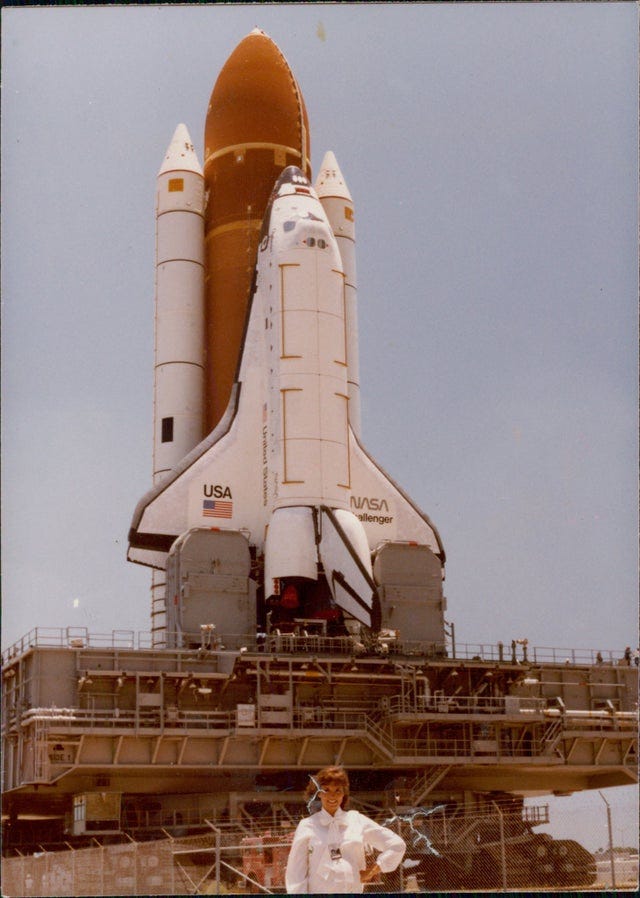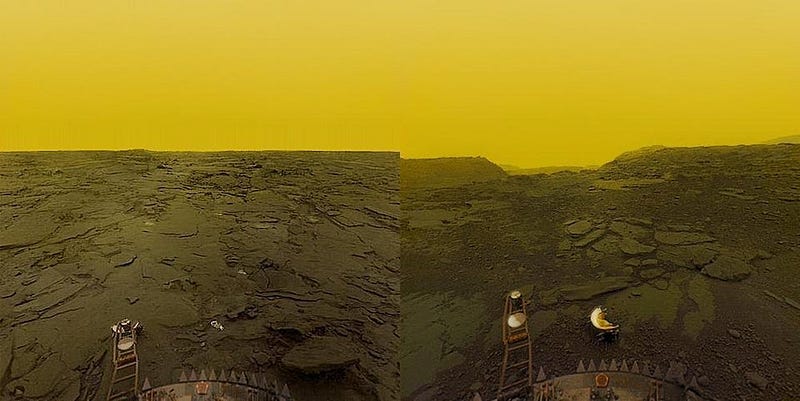Unveiling the Colorful Secrets of Venus: A Journey Through Space
Written on
Chapter 1: The Surprising Discovery of Color Photos from Venus
Growing up in the vicinity of NASA, I was immersed in a world of space exploration. My bedroom was plastered with stickers from various shuttle missions, and I had the privilege of attending several launches. My grandfather was involved in launch operations, and my mother spent three years working at NASA. Here’s a nostalgic family photo of her, pregnant with me, in front of The Challenger:

Despite my deep-rooted fascination with space, I was astonished to discover that there were actual photographs taken from the surface of Venus. This revelation completely escaped my attention during my childhood obsessed with space. How had I never come across this? Perhaps the acknowledgment of Russian achievements in space was overshadowed by a more patriotic focus on American endeavors.
The photos of Venus are, after all, a legacy of the Cold War, a time when competition with the USSR spurred remarkable advancements in space technology. The same political climate that prompted the development of formidable weapons also fueled incredible innovations in exploration. There was an undeniable drive to be the first and the best in space.
Why Were These Photos Hidden?
The Soviet Union was notoriously secretive about its space missions. Like many communist regimes, information was tightly controlled, and any mission that faced challenges was not reported on immediately. This veil of secrecy caught the world off guard when Sputnik, the first artificial satellite, was launched. The same secrecy surrounded the images taken on Venus, which were equally surprising to the global community.
In the early 1900s, Venus was romanticized as Earth's twin, often appearing in science fiction narratives. The Soviet Union saw this planet as an ideal target for exploration and recognition.
However, landing a probe on Venus posed a significant challenge due to its extreme conditions. The environment is so inhospitable that Mars seems inviting by comparison. Temperatures soar above 800 degrees Fahrenheit, and the atmosphere is filled with acidic clouds that move at hurricane speeds, while the pressure is equivalent to 83 times that of Earth's atmosphere.
Both NASA and the USSR faced initial failures in sending probes to Venus. Russia eventually achieved success with Venera 10, though its photos were limited as they only captured the ground below.
The turning point came with Venera 13, which was engineered with a robust exterior that allowed it to land successfully. Unfortunately, its operational time was limited to just 127 minutes. During its brief mission, it drilled into the Venusian soil, analyzed the samples, and sent back critical data on temperature and pressure, confirming the planet's hellish landscape. Additionally, it managed to capture 14 color photos and eight black-and-white images.
The first images released were not particularly impressive:

Venus is home to the most volcanic activity in our solar system, resulting in a surface that appears rugged and fragmented. The most comparable terrain on Earth would be found in recently cooled volcanic regions, such as those in Hawaii.
Despite the challenges, Venera 13 successfully obtained a few more photos, culminating in a remarkable pair that showcased the planet's surface along with its bizarre atmosphere:

In the right section of the image, you can see part of the camera lens that detached during the mission. The rover faced operational difficulties, yet it managed to take these images while attempting panoramic shots. The surface itself resembles a nightmarish vision, yet within its eerie beauty lies a captivating allure. The right half of the photo is, to me, the most stunning image captured of another planet—period.
Today, there are ongoing discussions between Russia and Japan regarding a potential long-term mission to Venus. Advancements in space travel and material science could enable a properly shielded craft to conduct experiments over several months.
Let’s take a moment to appreciate that we have been sending robotic explorers to other planets since the 1970s. Amidst the chaos and discord in our world, it’s easy to overlook the remarkable achievements of humanity. When we unite our efforts, we are capable of extraordinary accomplishments.
What Does Venus ACTUALLY Look Like?
This video explores the fascinating visual characteristics of Venus, utilizing data gathered from past missions.
The First and Only Photos From Venus - What Did We See? (4K)
An in-depth look at the groundbreaking images captured from Venus, revealing the planet's unique features and conditions.
Enjoy this? Subscribe to my newsletter for free content.